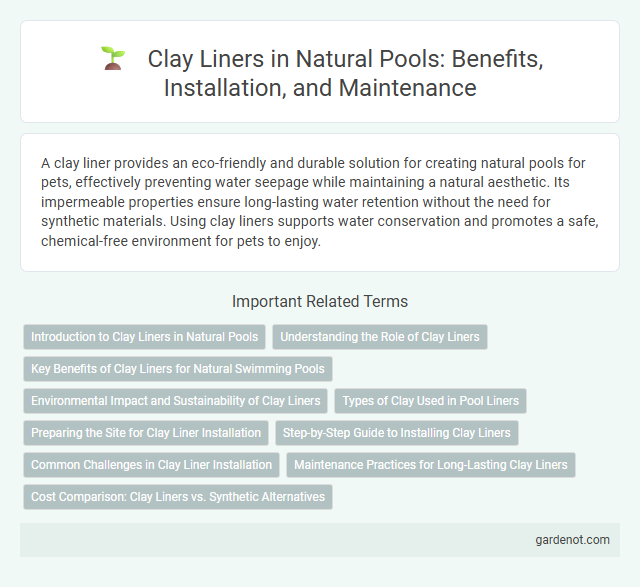A clay liner provides an eco-friendly and durable solution for creating natural pools for pets, effectively preventing water seepage while maintaining a natural aesthetic. Its impermeable properties ensure long-lasting water retention without the need for synthetic materials. Using clay liners supports water conservation and promotes a safe, chemical-free environment for pets to enjoy.
Introduction to Clay Liners in Natural Pools
Clay liners are an eco-friendly waterproofing solution widely used in natural pools to prevent water seepage into the ground. Made from highly compacted bentonite clay, these liners create a dense, impermeable barrier that is both durable and chemically inert. Their natural composition ensures compatibility with the pool's ecosystem, promoting sustainability and reducing the need for synthetic materials.
Understanding the Role of Clay Liners
Clay liners serve as a natural, impermeable barrier in natural pools, preventing water seepage into the surrounding soil and maintaining water levels. Their high plasticity and low permeability ensure effective water retention while supporting the pool's ecological balance without synthetic materials. This eco-friendly solution enhances sustainability by using locally sourced clay, reducing environmental impact and promoting natural filtration.
Key Benefits of Clay Liners for Natural Swimming Pools
Clay liners provide exceptional waterproofing for natural swimming pools by creating a dense, impermeable barrier that prevents water seepage. Their natural, non-toxic composition supports ecosystem balance and promotes healthy aquatic life without the need for chemicals. Additionally, clay liners offer durability and easy maintenance, ensuring long-term cost efficiency and environmental sustainability.
Environmental Impact and Sustainability of Clay Liners
Clay liners provide a highly sustainable solution for natural pools due to their eco-friendly composition and low environmental footprint. Their natural impermeability ensures minimal water loss and prevents contamination of surrounding soil and groundwater, supporting ecosystem health. Utilizing locally sourced clay reduces transportation emissions, making clay liners an environmentally responsible choice for sustainable pool construction.
Types of Clay Used in Pool Liners
Bentonite clay, known for its high swelling capacity and impermeability, is the most commonly used clay in natural pool liners, providing excellent water retention and leak prevention. Sodium montmorillonite clay is preferred for its ability to create a dense, stable barrier that enhances natural filtration in pool systems. Other clay types, like kaolin and illite, may be used in combination to improve structural integrity and flexibility of the pool liner.
Preparing the Site for Clay Liner Installation
Preparing the site for clay liner installation involves thoroughly excavating and leveling the natural pool basin to ensure a uniform surface. Compaction of the soil subbase is critical to prevent settling and to maintain the integrity of the clay liner. Proper grading and drainage management around the site minimize potential water infiltration underneath the liner, enhancing its longevity and effectiveness.
Step-by-Step Guide to Installing Clay Liners
Installing a clay liner for a natural pool begins by excavating the pool area to the desired shape and depth, ensuring a smooth and well-compacted base to prevent future settling. Next, apply a uniform layer of bentonite clay, typically 6 to 12 inches thick, while progressively mixing and compacting the clay to create a dense, impermeable barrier that prevents water leakage. Finally, cover the clay liner with a protective layer of sand or fine gravel before adding water and aquatic plants to maintain the pool's natural filtration system.
Common Challenges in Clay Liner Installation
Clay liner installation in natural pools often faces challenges such as achieving uniform compaction to prevent leaks and ensuring adequate thickness to resist punctures from sharp objects. Proper moisture content is critical during installation to maintain clay's impermeability and avoid cracking as it dries. Uneven subgrade preparation can lead to settlement issues, compromising the liner's integrity and long-term water retention.
Maintenance Practices for Long-Lasting Clay Liners
Maintaining a clay liner in a natural pool requires regular inspection for cracks or leaks to prevent water loss and contamination. Proper compaction and periodic rehydration of the clay surface help preserve its impermeability and structural integrity. Avoiding mechanical damage by limiting heavy foot traffic and removing sharp objects ensures the liner's durability over time.
Cost Comparison: Clay Liners vs. Synthetic Alternatives
Clay liners for natural pools typically cost between $1 and $3 per square foot, offering a durable and eco-friendly option with excellent impermeability. Synthetic liners, such as PVC or EPDM, range from $2 to $5 per square foot but may require more frequent replacement and pose environmental concerns due to their chemical composition. Considering lifespan and maintenance, clay liners often provide a more cost-effective and sustainable solution for natural pool construction.
Clay liner Infographic

 gardenot.com
gardenot.com